check engine Acura MDX 2015 User Guide
[x] Cancel search | Manufacturer: ACURA, Model Year: 2015, Model line: MDX, Model: Acura MDX 2015Pages: 79, PDF Size: 16.44 MB
Page 59 of 79
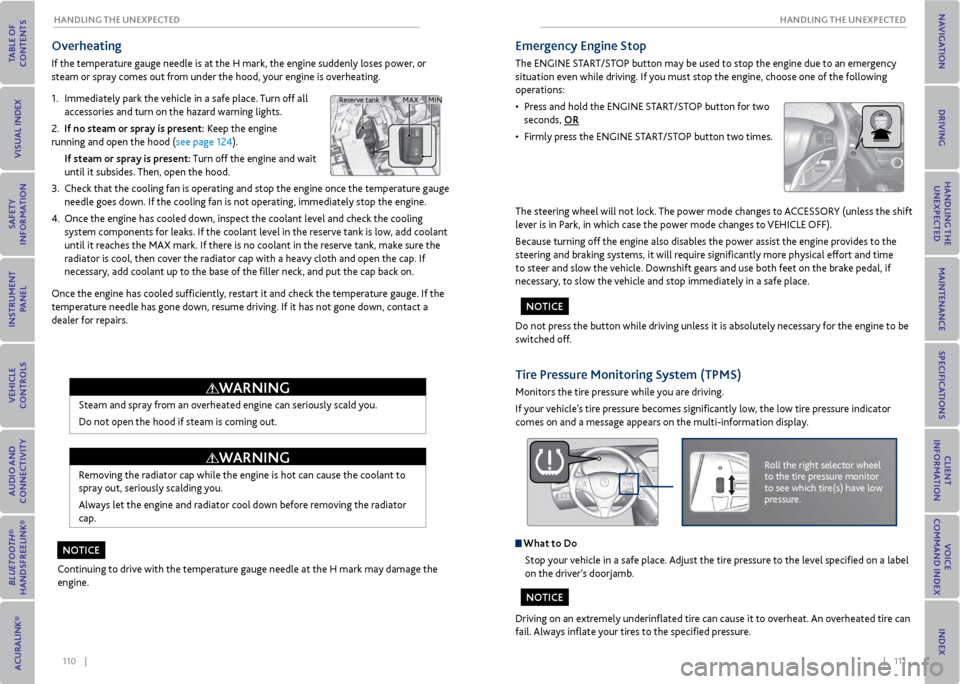
110 || 111
HANDLING THe UNexPeCTeD
HANDLING THe UNexPeCTeD
overheating
If the temperature gauge needle is at the H mark, the engine suddenly loses power, or
steam or spray comes out from under the hood, your engine is overheating.
1. Immediately park the vehicle in a safe place. Turn off all
accessories and turn on the hazard warning lights.
2. If no steam or spray is present: Keep the engine
running and open the hood (see page 124).
If steam or spray is present: Turn off the engine and wait
until it subsides. Then, open the hood.
3. Check that the cooling fan is operating and stop the engine once the temperature gauge
needle goes down. If the cooling fan is not operating, immediately stop the engine.
4. Once the engine has cooled down, inspect the coolant level and check the cooling
system components for leaks. If the coolant level in the reserve tank is low, add coolant
until it reaches the MAX mark. If there is no coolant in the reserve tank, make sure the
radiator is cool, then cover the radiator cap with a heavy cloth and open the cap. If
necessary, add coolant up to the base of the filler neck, and put the cap back on.
Once the engine has cooled sufficiently, restart it and check the temperature gauge. If the
temperature needle has gone down, resume driving. If it has not gone down, contact a
dealer for repairs.
Steam and spray from an overheated engine can seriously scald you.
Do not open the hood if steam is coming out.
Removing the radiator cap while the engine is hot can cause the coolant to
spray out, seriously scalding you.
Always let the engine and radiator cool down before removing the radiator
cap.
Continuing to drive with the temperature gauge needle at the H mark may damage the
engine.
MAX MIN
Reserve tank
WArNING
WArNING
No TICe
emergency engine Stop
The ENGINE START/STOP button may be used to stop the engine due to an emergency
situation even while driving. If you must stop the engine, choose one of the following
operations:
• Press and hold the ENGINE START/STOP button for two
seconds, or
• Firmly press the ENGINE START/STOP button two times.
The steering wheel will not lock. The power mode changes to ACCESSORY (unless the shift
lever is in Park, in which case the power mode changes to VEHICLE OFF).
Because turning off the engine also disables the power assist the engine provides to the
steering and braking systems, it will require significantly more physical effort and time
to steer and slow the vehicle. Downshift gears and use both feet on the brake pedal, if
necessary, to slow the vehicle and stop immediately in a safe place.
Do not press the button while driving unless it is absolutely necessary for the engine to be
switched off.
Tire Pressure monitoring System (TPmS)
Monitors the tire pressure while you are driving.
If your vehicle’s tire pressure becomes significantly low, the low tire pressure indicator
comes on and a message appears on the multi-information display.
Roll the right selector wheel
to the tire pressure monitor
to see which tire(s) have low
pressure.
What to Do Stop your vehicle in a safe place. Adjust the tire pressure to the level specified on a label
on the driver’s doorjamb.
Driving on an extremely underinflated tire can cause it to overheat. An overheated tire can
fail. Always inflate your tires to the specified pressure.
No TICe
NoTICe
Page 64 of 79
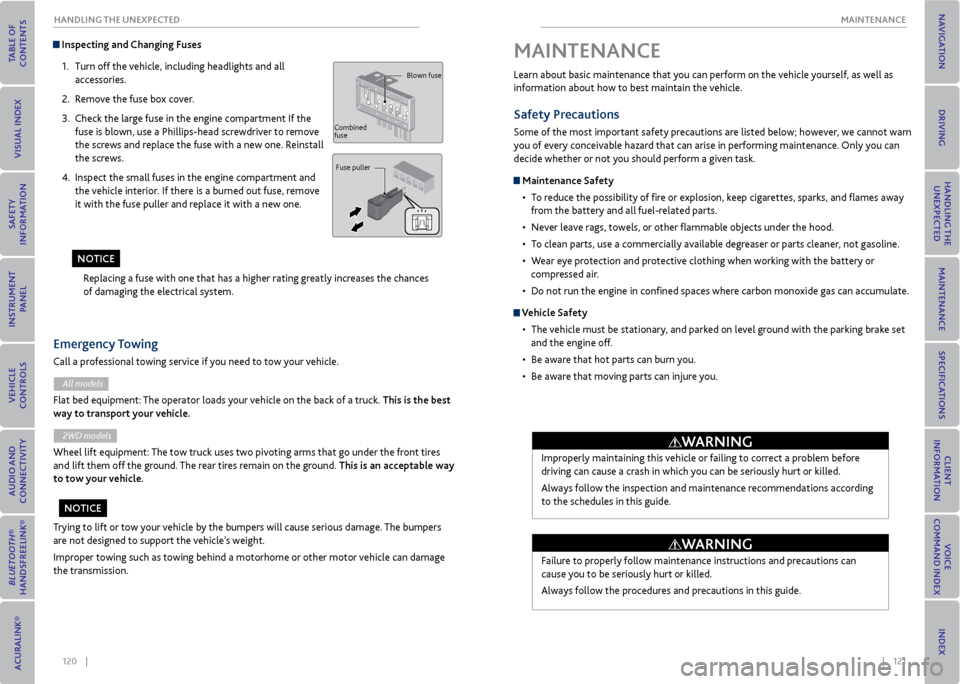
120 || 121
mAINTeNANCe
HANDLING THe UNexPeCTeD
Inspecting and Changing Fuses
1. Turn off the vehicle, including headlights and all
accessories.
2. Remove the fuse box cover.
3. Check the large fuse in the engine compartment If the
fuse is blown, use a Phillips-head screwdriver to remove
the screws and replace the fuse with a new one. Reinstall
the screws.
4. Inspect the small fuses in the engine compartment and
the vehicle interior. If there is a burned out fuse, remove
it with the fuse puller and replace it with a new one.
Replacing a fuse with one that has a higher rating greatly increases the chances
of damaging the electrical system.
Blown fuse
Combined
fuse Fuse puller
Trying to lift or tow your vehicle by the bumpers will cause serious damage. The bumpers
are not designed to support the vehicle’s weight.
Improper towing such as towing behind a motorhome or other motor vehicle can damage
the transmission.
emergency Towing
Call a professional towing service if you need to tow your vehicle.
All models
Flat bed equipment: The operator loads your vehicle on the back of a truck. This is the best
way to transport your vehicle.
2WD models
Wheel lift equipment: The tow truck uses two pivoting arms that go under the front tires
and lift them off the ground. The rear tires remain on the ground. This is an acceptable way
to tow your vehicle.
No TICe
NoTICe Learn about basic maintenance that you can perform on the vehicle yourself, as well as
information about how to best maintain the vehicle.
Safety Precautions
Some of the most important safety precautions are listed below; however, we cannot warn
you of every conceivable hazard that can arise in performing maintenance. Only you can
decide whether or not you should perform a given task.
maintenance Safety
• To reduce the possibility of fire or explosion, keep cigarettes, sparks, and flames away
from the battery and all fuel-related parts.
• Never leave rags, towels, or other flammable objects under the hood.
• To clean parts, use a commercially available degreaser or parts cleaner, not gasoline.
• Wear eye protection and protective clothing when working with the battery or
compressed air.
• Do not run the engine in confined spaces where carbon monoxide gas can accumulate.
vehicle Safety
• The vehicle must be stationary, and parked on level ground with the parking brake set
and the engine off.
• Be aware that hot parts can burn you.
• Be aware that moving parts can injure you.
mAINTeNANCe
Improperly maintaining this vehicle or failing to correct a problem before
driving can cause a crash in which you can be seriously hurt or killed.
Always follow the inspection and maintenance recommendations according
to the schedules in this guide.
Failure to properly follow maintenance instructions and precautions can
cause you to be seriously hurt or killed.
Always follow the procedures and precautions in this guide.
WArNING
WArNING
Page 65 of 79
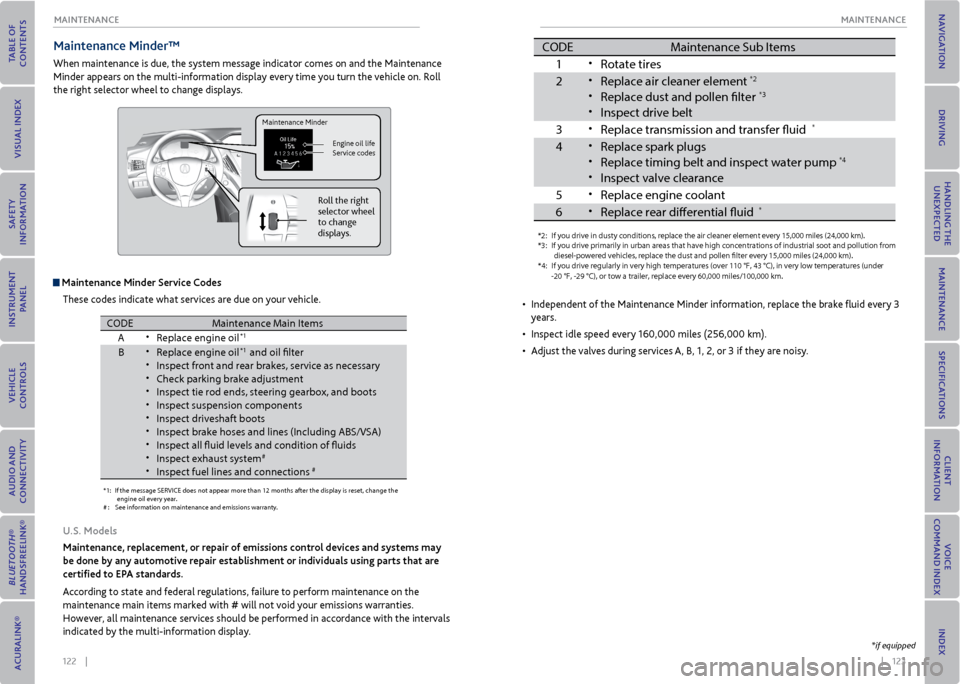
122 || 123
mAINTeNANCe
mAINTeNANCe
maintenance minder™
When maintenance is due, the system message indicator comes on and the Maintenance
Minder appears on the multi-information display every time you turn the vehicle on. Roll
the right selector wheel to change displays.
maintenance minder Service Codes
These codes indicate what services are due on your vehicle.
*1: If the message SERVICE does not appear more than 12 months after the display is\
reset, change the
engine oil every year .
#: See information on maintenance and emissions warranty.
CODEMaintenance Main Items
A
•Replace engine oi l*1
B•Replace engine oil*1 and oil flter•Inspect front and rear brakes, service as necessar y•Check parking brake adjustment•Inspect tie rod ends, steering gearbox, and boot s•Inspect suspension components•Inspect driveshaft boots•Inspect brake hoses and lines (Including ABS/VSA)•Inspect all fuid levels and condition of fuid s•Inspect exhaust system#
•Inspect fuel lines and connections#
*4:If you drive regularly in very high temperatures (over 110 °F, 43 °\
C), in very low temperatures (unde r
-20 °F, -29 °C), or tow a trai ler, repl ace ever y 60,000 mi les/100,000 km .
CODE Maintenance Sub Items
1
•Rotate tires
2
•Replace air cleaner element*2
•Replace dust and pollen flte r*3
•Inspect drive belt
3
•Replace transmission and transfer fuid*
4•Replace spark plug s•Replace timing belt an d inspect water pump*4
•Inspect valve clearanc
e
5
•Replace engine coolan t
6
•Replace rear diferential fuid*
*2:I f you drive in dusty condi tion s, replac e the air cleaner element every 15,000 miles (24,000 km).
*3: If you drive primarily in urban areas that have high concentrations of i\
ndustrial soot and pollution from
diesel-powered vehicles, replace the dust and pollen flter every 15,000 miles (24,000 km).
U.S. models
maintenance, replacement, or repair of emissions control devices and systems may
be done by any automotive repair establishment or individuals using parts that are
certified to ePA standards.
According to state and federal regulations, failure to perform maintenance on the
maintenance main items marked with # will not void your emissions warranties.
However, all maintenance services should be performed in accordance with the intervals
indicated by the multi-information display.
Maintenance Minder
Engine oil life
Service codes
Roll the right
selector wheel
to change
displays.
*1: If the message SERVICE does not appear more than 12 months after the display is\
reset, change the
engine oil every year .
#: See information on maintenance and emissions warranty.
CODEMaintenance Main Item s
A
•Replace engine oi l*1
B•Replace engine oil*1 and oil flter
•Inspect front and rear brakes, service as necessar y
•Check parking brake adjustment
•Inspect tie rod ends, steering gearbox, and boot s
•Inspect suspension components
•Inspect driveshaft boots
•Inspect brake hoses and lines (Including ABS/VSA)
•Inspect all fuid levels and condition of fuid s
•Inspect exhaust system#
•Inspect fuel lines and connections#
*4:If you drive regularly in very high temperatures (over 110 °F, 43 °\
C), in very low temperatures (unde r
-20 °F, -29 °C), or tow a trai ler, repl ace ever y 60,000 mi les/100,000 km .
CODEMaintenance Sub Item s
1
•Rotate tires
2•Replace air cleaner element*2
•Replace dust and pollen flte r*3
•Inspect drive belt
3
•Replace transmission and transfer fuid*
4•Replace spark plug s
•Replace timing belt an d inspect water pump*4
•Inspect valve clearanc
e
5
•Replace engine coolan t
6•Replace rear diferential fuid*
*2:If you drive in dusty condi tion s, replac e the air cleaner element every 15,000 miles (24,000 km).
*3: If you drive primarily in urban areas that have high concentrations of i\
ndustrial soot and pollution from
diesel-powered vehicles, replace the dust and pollen flter every 15,000 miles (24,000 km).
• Independent of the Maintenance Minder information, replace the brake fluid every 3
years.
• Inspect idle speed every 160,000 miles (256,000 km).
• Adjust the valves during services A, B, 1, 2, or 3 if they are noisy.
*if equipped
Page 66 of 79
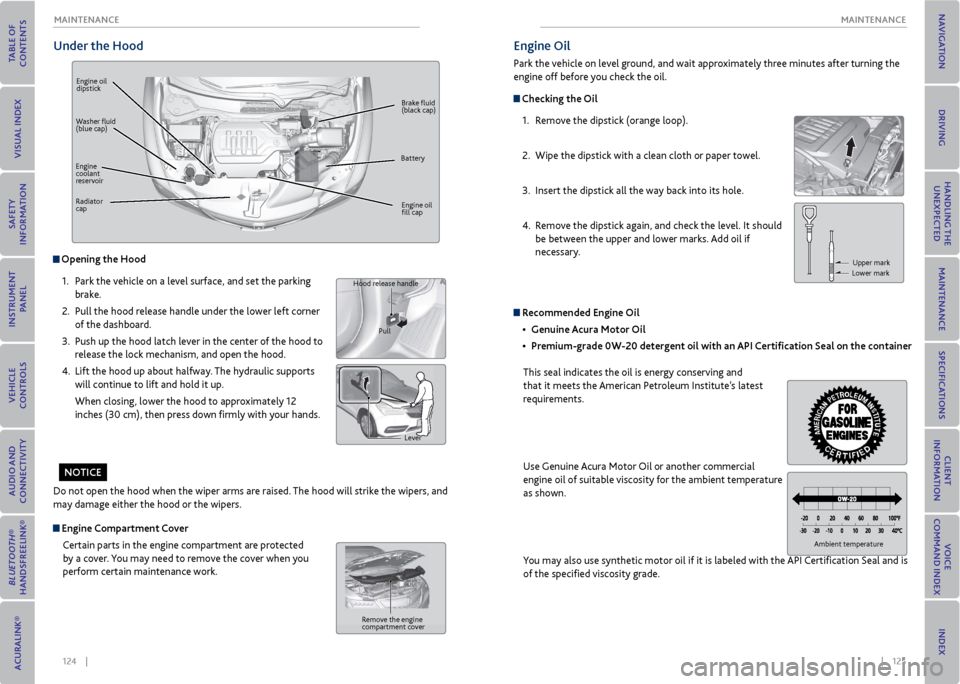
124 || 125
mAINTeNANCe
mAINTeNANCe
Under the Hood
Engine oil
dipstick
Brake fluid
(black cap)
Engine oil
fill cap
Washer fluid
(blue cap)
Battery
Engine
coolant
reservoir
Radiator
cap
opening the Hood
1. Park the vehicle on a level surface, and set the parking
brake.
2. Pull the hood release handle under the lower left corner
of the dashboard.
3. Push up the hood latch lever in the center of the hood to
release the lock mechanism, and open the hood.
4. Lift the hood up about halfway. The hydraulic supports
will continue to lift and hold it up.
When closing, lower the hood to approximately 12
inches (30 cm), then press down firmly with your hands.
Do not open the hood when the wiper arms are raised. The hood will strike the wipers, and
may damage either the hood or the wipers.
Hood release handle
Pull
Lever
engine Compartment CoverCertain parts in the engine compartment are protected
by a cover. You may need to remove the cover when you
perform certain maintenance work.
Remove the engine
compartment cover
No TICe
engine oil
Park the vehicle on level ground, and wait approximately three minutes after turning the
engine off before you check the oil.
Checking the oil
1. Remove the dipstick (orange loop).
2. Wipe the dipstick with a clean cloth or paper towel.
3. Insert the dipstick all the way back into its hole.
4. Remove the dipstick again, and check the level. It should
be between the upper and lower marks. Add oil if
necessary.
Upper mark
Lower mark
Ambient temperature
r ecommended engine oil
• Genuine Acura motor oil
• Premium-grade 0W-20 detergent oil with an API Certification Seal on the container
This seal indicates the oil is energy conserving and
that it meets the American Petroleum Institute’s latest
requirements.
Use Genuine Acura Motor Oil or another commercial
engine oil of suitable viscosity for the ambient temperature
as shown.
You may also use synthetic motor oil if it is labeled with the API Certification Seal and is
of the specified viscosity grade.
Page 67 of 79
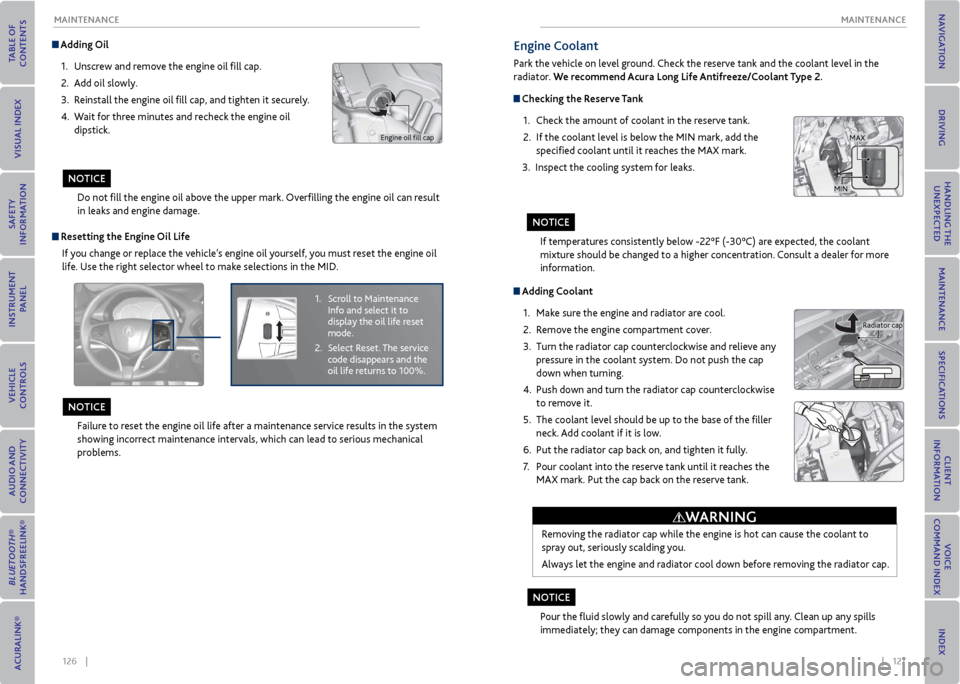
126 || 127
mAINTeNANCe
mAINTeNANCe
Adding oil
1. Unscrew and remove the engine oil fill cap.
2. Add oil slowly.
3. Reinstall the engine oil fill cap, and tighten it securely.
4. Wait for three minutes and recheck the engine oil
dipstick.
Do not fill the engine oil above the upper mark. Overfilling the engine oil can result
in leaks and engine damage.
Engine oil fill cap
r esetting the engine oil Life
If you change or replace the vehicle’s engine oil yourself, you must reset the engine oil
life. Use the right selector wheel to make selections in the MID.
Failure to reset the engine oil life after a maintenance service results in the system
showing incorrect maintenance intervals, which can lead to serious mechanical
problems.
1. Scroll to Maintenance
Info and select it to
display the oil life reset
mode.
2. Select Reset. The service
code disappears and the
oil life returns to 100%.
No TICe
NoTICe
Adding Coolant
1. Make sure the engine and radiator are cool.
2. Remove the engine compartment cover.
3. Turn the radiator cap counterclockwise and relieve any
pressure in the coolant system. Do not push the cap
down when turning.
4. Push down and turn the radiator cap counterclockwise
to remove it.
5. The coolant level should be up to the base of the filler
neck. Add coolant if it is low.
6. Put the radiator cap back on, and tighten it fully.
7. Pour coolant into the reserve tank until it reaches the
MAX mark. Put the cap back on the reserve tank.
Removing the radiator cap while the engine is hot can cause the coolant to
spray out, seriously scalding you.
Always let the engine and radiator cool down before removing the radiator cap.
Pour the fluid slowly and carefully so you do not spill any. Clean up any spills
immediately; they can damage components in the engine compartment.
Radiator cap
WArNING
engine Coolant
Park the vehicle on level ground. Check the reserve tank and the coolant level in the
radiator. We recommend Acura Long Life Antifreeze/Coolant Type 2.
Checking the reserve Tank
1. Check the amount of coolant in the reserve tank.
2. If the coolant level is below the MIN mark, add the
specified coolant until it reaches the MAX mark.
3. Inspect the cooling system for leaks.
If temperatures consistently below -22°F (-30°C) are expected, the coolant
mixture should be changed to a higher concentration. Consult a dealer for more
information.
MAX
MIN
No TICe
NoTICe
Page 68 of 79
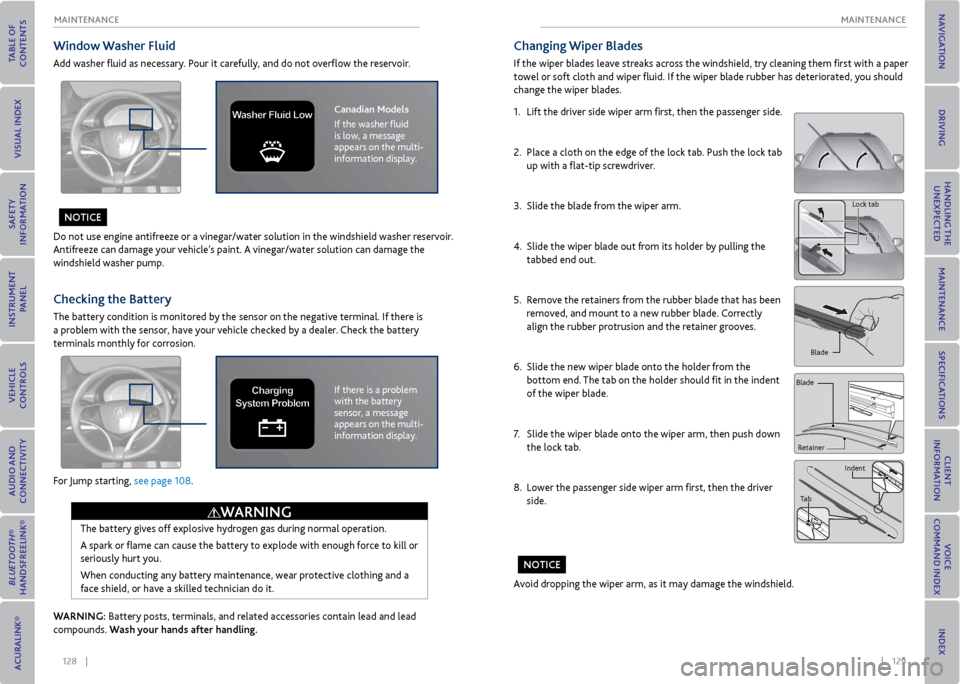
128 || 129
mAINTeNANCe
mAINTeNANCe
Window Washer Fluid
Add washer fluid as necessary. Pour it carefully, and do not overflow the reservoir.
Do not use engine antifreeze or a vinegar/water solution in the windshield washer reservoir.
Antifreeze can damage your vehicle’s paint. A vinegar/water solution can damage the
windshield washer pump.
For Jump starting, see page 108.
Checking the Battery
The battery condition is monitored by the sensor on the negative terminal. If there is
a problem with the sensor, have your vehicle checked by a dealer. Check the battery
terminals monthly for corrosion.
The battery gives off explosive hydrogen gas during normal operation.
A spark or flame can cause the battery to explode with enough force to kill or
seriously hurt you.
When conducting any battery maintenance, wear protective clothing and a
face shield, or have a skilled technician do it.
WArNING
Canadian models
If the washer fluid
is low, a message
appears on the multi-
information display.Washer Fluid Lo w
WArNING: Battery posts, terminals, and related accessories contain lead and lead
compounds. Wash your hands after handling.
If there is a problem
with the battery
sensor, a message
appears on the multi-
information display.Charging
System Problem
No TICe
Changing Wiper Blades
If the wiper blades leave streaks across the windshield, try cleaning them first with a paper
towel or soft cloth and wiper fluid. If the wiper blade rubber has deteriorated, you should
change the wiper blades.
1. Lift the driver side wiper arm first, then the passenger side.
2. Place a cloth on the edge of the lock tab. Push the lock tab
up with a flat-tip screwdriver.
3. Slide the blade from the wiper arm.
4. Slide the wiper blade out from its holder by pulling the
tabbed end out.
5. Remove the retainers from the rubber blade that has been
removed, and mount to a new rubber blade. Correctly
align the rubber protrusion and the retainer grooves.
6. Slide the new wiper blade onto the holder from the
bottom end. The tab on the holder should fit in the indent
of the wiper blade.
7. Slide the wiper blade onto the wiper arm, then push down
the lock tab.
8. Lower the passenger side wiper arm first, then the driver
side.
Lock tab
Blade
Retainer
Blade
Indent
Tab
Avoid dropping the wiper arm, as it may damage the windshield.
No TICe
Page 72 of 79
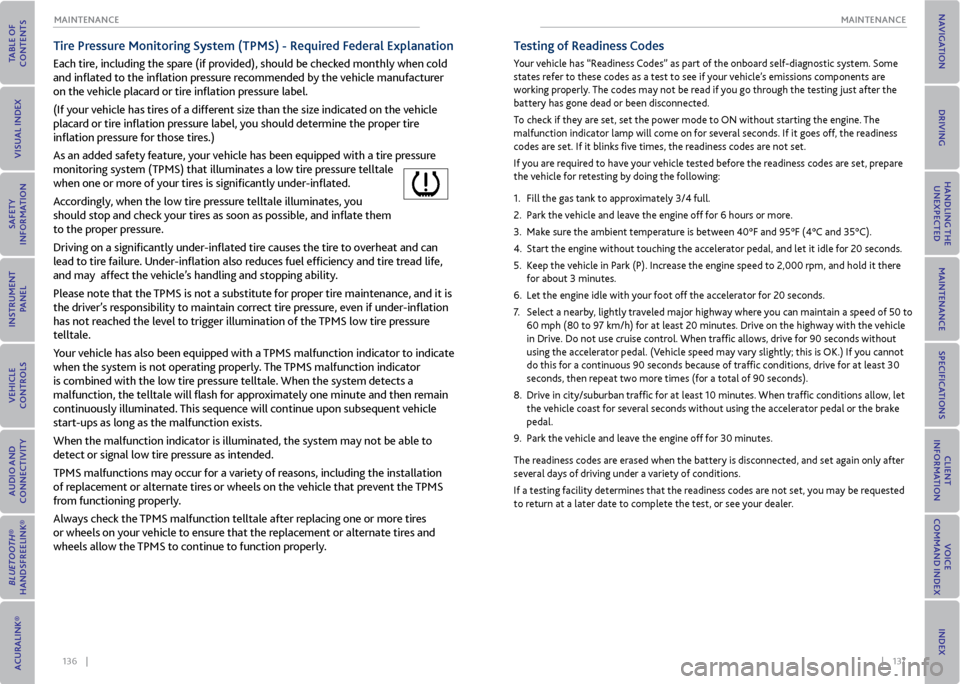
136 || 137
mAINTeNANCe
mAINTeNANCe
Tire Pressure monitoring System (TPmS) - r equired Federal explanation
Each tire, including the spare (if provided), should be checked monthly when cold
and inflated to the inflation pressure recommended by the vehicle manufacturer
on the vehicle placard or tire inflation pressure label.
(If your vehicle has tires of a different size than the size indicated on the vehicle
placard or tire inflation pressure label, you should determine the proper tire
inflation pressure for those tires.)
As an added safety feature, your vehicle has been equipped with a tire pressure
monitoring system (TPMS) that illuminates a low tire pressure telltale
when one or more of your tires is significantly under-inflated.
Accordingly, when the low tire pressure telltale illuminates, you
should stop and check your tires as soon as possible, and inflate them
to the proper pressure.
Driving on a significantly under-inflated tire causes the tire to overheat and can
lead to tire failure. Under-inflation also reduces fuel efficiency and tire tread life,
and may affect the vehicle’s handling and stopping ability.
Please note that the TPMS is not a substitute for proper tire maintenance, and it is
the driver’s responsibility to maintain correct tire pressure, even if under-inflation
has not reached the level to trigger illumination of the TPMS low tire pressure
telltale.
Your vehicle has also been equipped with a TPMS malfunction indicator to indicate
when the system is not operating properly. The TPMS malfunction indicator
is combined with the low tire pressure telltale. When the system detects a
malfunction, the telltale will flash for approximately one minute and then remain
continuously illuminated. This sequence will continue upon subsequent vehicle
start-ups as long as the malfunction exists.
When the malfunction indicator is illuminated, the system may not be able to
detect or signal low tire pressure as intended.
TPMS malfunctions may occur for a variety of reasons, including the installation
of replacement or alternate tires or wheels on the vehicle that prevent the TPMS
from functioning properly.
Always check the TPMS malfunction telltale after replacing one or more tires
or wheels on your vehicle to ensure that the replacement or alternate tires and
wheels allow the TPMS to continue to function properly.
Testing of readiness Codes
Your vehicle has “Readiness Codes” as part of the onboard self-diagnostic system. Some
states refer to these codes as a test to see if your vehicle’s emissions components are
working properly. The codes may not be read if you go through the testing just after the
battery has gone dead or been disconnected.
To check if they are set, set the power mode to ON without starting the engine. The
malfunction indicator lamp will come on for several seconds. If it goes off, the readiness
codes are set. If it blinks five times, the readiness codes are not set.
If you are required to have your vehicle tested before the readiness codes are set, prepare
the vehicle for retesting by doing the following:
1. Fill the gas tank to approximately 3/4 full.
2. Park the vehicle and leave the engine off for 6 hours or more.
3. Make sure the ambient temperature is between 40°F and 95°F (4°C and 35°C).
4. Start the engine without touching the accelerator pedal, and let it idle for 20 seconds.
5. Keep the vehicle in Park (P). Increase the engine speed to 2,000 rpm, and hold it there
for about 3 minutes.
6. Let the engine idle with your foot off the accelerator for 20 seconds.
7. Select a nearby, lightly traveled major highway where you can maintain a speed of 50 to
60 mph (80 to 97 km/h) for at least 20 minutes. Drive on the highway with the vehicle
in Drive. Do not use cruise control. When traffic allows, drive for 90 seconds without
using the accelerator pedal. (Vehicle speed may vary slightly; this is OK.) If you cannot
do this for a continuous 90 seconds because of traffic conditions, drive for at least 30
seconds, then repeat two more times (for a total of 90 seconds).
8. Drive in city/suburban traffic for at least 10 minutes. When traffic conditions allow, let
the vehicle coast for several seconds without using the accelerator pedal or the brake
pedal.
9. Park the vehicle and leave the engine off for 30 minutes.
The readiness codes are erased when the battery is disconnected, and set again only after
several days of driving under a variety of conditions.
If a testing facility determines that the readiness codes are not set, you may be requested
to return at a later date to complete the test, or see your dealer.
Page 73 of 79
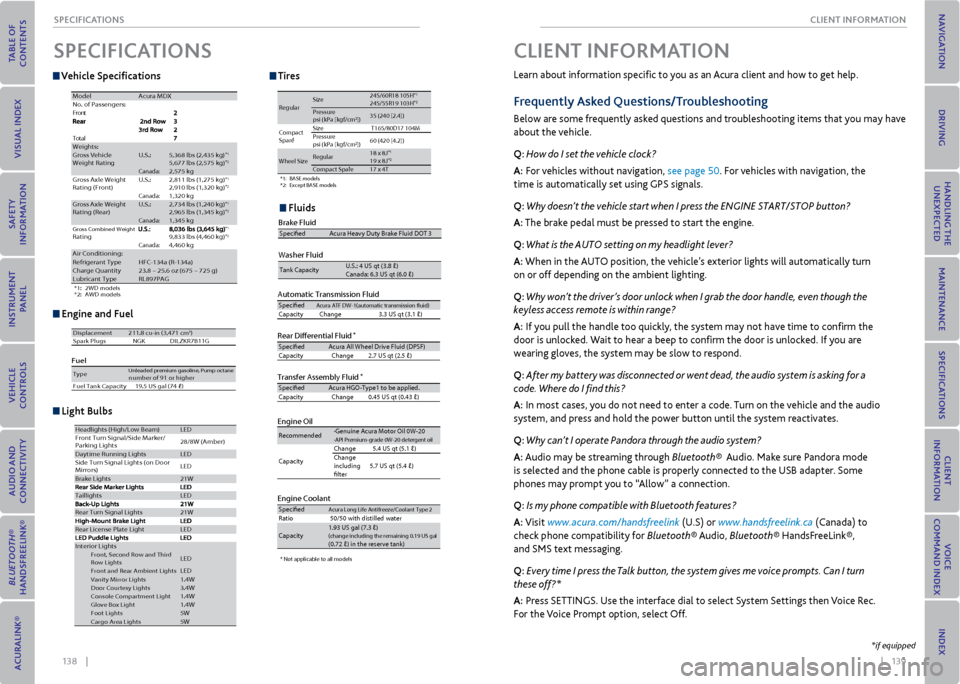
138 || 139
CLIeNT INFormATIoN
SPeCIFICATIoNS
v ehicle Specifications
engine and Fuel
Fluids
*1 :2 WD model s
*2 :A WD model s
ModelAcura MDX
No. of Passengers:
t
n
o
r
F
l
a
t
o
TWeights:Gross Vehicle
Weight Ratin gU.S.:5,368 lbs (2,435 kg)*15,677 lbs (2,575 kg)*2Canada:2,575 kgGross Axle Weight
Rating (Front )U.S.:2,811 lbs (1,275 kg )*12,910 lbs (1,320 kg)*2Canada:1,320 kgGross Axle Weight
Rating (R ear)U.S.:2,734 lbs (1,240 kg )*12,965 lbs (1,345 kg)*2Canada:1,345 kgGross Combined Weight Rating*19,833 lbs (4,460 kg )*2Canada:4,460 kgAir Conditioning :Refrigerant TypeHFC-134a (R-134a )Charge Quantity23.8 – 25.6 oz (675 – 725 g)Lubricant TypeRL897PAG
Engine Specifcatio\hn s
FuelDisplacement211.8 cu-in (3,471 cm3)
Spark Plug sN GKDILZKR7B11 G
TypeUnleaded premium gasoline, Pump octane number of 91 or higher
Fuel Tank Capacity 19.5 US gal (74 �)
Light \fulbsHeadl ights (High/Low Beam )LED
Front Turn Signal/Side Marker /
Parking Lights 28
/8W (A mber)
Daytime Running Light sLED
Si de Turn Si gnal Lights (on Door
Mirrors ) LED
Brake Lights21
W
Taillight sLED
Rear Turn Signal Li ghts21W
Rear License Plate Ligh tLED
Interior LightsFront, Second Row and Third
Ro w LightsLED
Front and Rear Ambient LightsLEDVa nity Mirror Lights 1.4WDoor Courtesy Lights3.4WConsole Compartment Ligh t1.4WGlove Box Ligh t1.4WFoot Lights5WCargo Area Lights5WAutomatic Transmis\Dsion Fluid
Rear Di\ferential Fl\Duid*
Transfer Assembl\b Fl\Duid*
Specife dAcura ATF DW-1(au\fo\(ma\fic \fran\bmi\b\bion fuid\( )Capaci\fy Change 3.3 US q \f (3.1 �)
Specife dAcura All Wheel Dr\(ive Fluid (DPSF )
Ca paci\fy Change2.7 US q\f (2.5 �)
Specife dAcura HGO-Type1 \fo \(be appli ed.
Ca paci\fy Change0.45 US q\f (0.43 �)
Engine Oil
Engine Coolant
Recommended·Genuine Acura Mo\for\( Oil 0W-20·API Premium-grade \(0W-20 de\fe rgen\f oil
Capaci\fy Change
5.4 US q\f (5.1 �)
Change
including
fl\fer 5.7 US q\f (5.4 �)
SpecifedAcura Long L
ife An\fifreeze/Cool\(an\f Type 2Ra\fio50/50 wi\fh di\b\filled\( wa\fer
Capaci\fy1.93 US g al (7.3 �)(change including \fhe\( remaining 0.19 US ga\(l (0.72 �) in \fhe re\ber\(ve \fank)
Tire
*1:B ASE model\b
*2 :E xcep\f BASE model \b
Regula r Size
245/60R18 105H
*1245/55R19 103H*2Pre\b\bure
p\b i (kPa [kgf/c m2])35 (24
0 [2.4])
Compac\f
Spar e
*Size T165/80D17 104M
Pre\b\bure
p\b i (kPa [kgf/cm
2]) 60 (42
0 [4.2])
Wheel Size Regular
18 x 8J*119 x 8J*2Compac\f Spare*17 x 4T
* Not applicable to all models
Washer Fluid
Tank Capaci\fyU.S.: 4 US q\f (3.8 �)
Ca nada: 6.3 US q\f (6.0 \(�)
Brake FluidSpecifedAcura Heavy Du\fy Br\(ake Fluid DOT 3
SPeCIFICATIoNS
*1:2 WD model s
*2 :A WD model s
ModelAcura MDX
No. of Passengers:
t
n
o
r
F
l
a
t
o
TWeights:Gross Vehicle
Weight Ratin gU.S.:5,368 lbs (2,435 kg)*15,677 lbs (2,575 kg)*2Canada:2,575 kgGross Axle Weight
Rating (Front )U.S.:2,811 lbs (1,275 kg )*12,910 lbs (1,320 kg)*2Canada:1,320 kgGross Axle Weight
Rating (R ear)U.S.:2,734 lbs (1,240 kg )*12,965 lbs (1,345 kg)*2Canada:1,345 kgGross Combined Weight Rating*19,833 lbs (4,460 kg )*2Canada:4,460 kgAir Conditioning :Refrigerant TypeHFC-134a (R-134a )Charge Quantity23.8 – 25.6 oz (675 – 725 g)Lubricant TypeRL897PAG
Engine Specifcatio\hn s
FuelDisplacement211.8 cu-in (3,471 cm3)
Spark Plug sN GKDILZKR7B11 G
TypeUnleaded premium gasoline, Pump octane number of 91 or higher
Fuel Tank Capacity 19.5 US gal (74 �)
Light \fulbsHeadl ights (High/Low Beam )LED
Front Turn Signal/Side Marker /
Parking Lights 28
/8W (A mber)
Daytime Running Light sLED
Si de Turn Si gnal Lights (on Door
Mirrors ) LED
Brake Lights21
W
Taillight sLED
Rear Turn Signal Li ghts21W
Rear License Plate Ligh tLED
Interior LightsFront, Second Row and Third
Ro w LightsLEDFront and Rear Ambient LightsLEDVa nity Mirror Lights 1.4WDoor Courtesy Lights3.4WConsole Compartment Ligh t1.4WGlove Box Ligh t1.4WFoot Lights5WCargo Area Lights5W
TiresAutomatic Transmis\Dsion Flui d
Rear Di\ferential Fl\Dui d
*
Transfer Assembl\b Fl\Duid*
SpecifedAcura ATF DW-1(au\fo\(ma\fic \fran\bmi\b\bion fuid\( )Capaci\fy Change 3.3 US q \f (3.1 �)
Specife d Acura All Wheel Dr\(ive Fluid (DPSF )
Ca paci\fy Change2.7 US q\f (2.5 �)
Specife d Acura HGO-Type1 \fo \(be appli ed.
Ca paci\fy Change0.45 US q\f (0.43 �)
Engine Oi l
Engine Coolan t
Recommended ·Genuine Acura Mo\for\( Oil 0W-20·API Premium-grade \(0W-20 de\fe
rgen\f oil
Capaci\fy Change
5.4 US q\f (5.1 �)
Change
including
fl\fer 5.7 US q\f (5.4 �)
Specifed
Acura Long L ife An\fifreeze/Cool\(an\f Type 2Ra\fio50/50 wi\fh di\b\filled\( wa\fer
Capaci\fy 1.93
US g al (7.3 �)
(change including \fhe\( remaining 0.19 US ga\(l (0.72 �) in \fhe re\ber\(ve \fank)
Tire
*1:B ASE model\b
*2 :E xcep\f BASE model \b
Regula rSize245/60R18 105H*1245/55R19 103H*2Pre\b\bure
p\b i (kPa [kgf/c m2])35 (240 [2.4])
Compac\f
Spar e
*Size T165/80D17 104M
Pre\b\bure
p\b i (kPa [kgf/cm
2]) 60 (42
0 [4.2])
Wheel SizeRegular18 x 8J*119 x 8J*2Compac\f Spare*17 x 4T
* Not applicable to all models
Washer Fluid
Tank Capaci\fy U.S.: 4 US q\f (3.8 �)
Ca nada: 6.3 US q\f (6.0 \(�)
Brake FluidSpecifed Acura Heavy Du\fy Br\(ake Fluid DOT 3
Light Bulbs
*1:2 WD model s
*2 :A WD model s
ModelAcura MDX
No. of Passengers:
t
n
o
r
F
l
a
t
o
TWeights:Gross Vehicle
Weight Ratin gU.S.:5,368 lbs (2,435 kg)*15,677 lbs (2,575 kg)*2Canada:2,575 kgGross Axle Weight
Rating (Front )U.S.:2,811 lbs (1,275 kg )*12,910 lbs (1,320 kg)*2Canada:1,320 kgGross Axle Weight
Rating (R ear)U.S.:2,734 lbs (1,240 kg )*12,965 lbs (1,345 kg)*2Canada:1,345 kgGross Combined Weight Rating*19,833 lbs (4,460 kg )*2Canada:4,460 kgAir Conditioning :Refrigerant TypeHFC-134a (R-134a )Charge Quantity23.8 – 25.6 oz (675 – 725 g)Lubricant TypeRL897PAG
Engine Specifcatio\hn s
FuelDisplacement211.8 cu-in (3,471 cm3)
Spark Plug sN GKDILZKR7B11 G
TypeUnleaded premium gasoline, Pump octane number of 91 or higher
Fuel Tank Capacity 19.5 US gal (74 �)
Light \fulbsHeadl ights (High/Low Beam )LED
Front Turn Signal/Side Marker /
Parking Lights 28
/8W (A mber)
Daytime Running Light sLED
Si de Turn Si gnal Lights (on Door
Mirrors ) LED
Brake Lights21
W
Taillight sLED
Rear Turn Signal Li ghts21W
Rear License Plate Ligh tLED
Interior LightsFront, Second Row and Third
Ro w LightsLED
Front and Rear Ambient LightsLEDVa nity Mirror Lights 1.4WDoor Courtesy Lights3.4WConsole Compartment Ligh t1.4WGlove Box Ligh t1.4WFoot Lights5WCargo Area Lights5W
Learn about information specific to you as an Acura client and how to get help.
Frequently Asked Questions/Troubleshooting
Below are some frequently asked questions and troubleshooting items that you may have
about the vehicle.
Q: How do I set the vehicle clock?
A: For vehicles without navigation, see page 50. For vehicles with navigation, the
time is automatically set using GPS signals.
Q: Why doesn’t the vehicle start when I press the ENGINE START/STOP button?
A: The brake pedal must be pressed to start the engine.
Q: What is the AUTO setting on my headlight lever?
A: When in the AUTO position, the vehicle’s exterior lights will automatically turn
on or off depending on the ambient lighting.
Q: Why won’t the driver’s door unlock when I grab the door handle, even though the
keyless access remote is within range?
A: If you pull the handle too quickly, the system may not have time to confirm the
door is unlocked. Wait to hear a beep to confirm the door is unlocked. If you are
wearing gloves, the system may be slow to respond.
Q: After my battery was disconnected or went dead, the audio system is asking for a
code. Where do I find this?
A: In most cases, you do not need to enter a code. Turn on the vehicle and the audio
system, and press and hold the power button until the system reactivates.
Q: Why can’t I operate Pandora through the audio system?
A: Audio may be streaming through Bluetooth® Audio. Make sure Pandora mode
is selected and the phone cable is properly connected to the USB adapter. Some
phones may prompt you to “Allow” a connection.
Q: Is my phone compatible with Bluetooth features?
A: Visit www.acura.com/handsfreelink (U.S) or www.handsfreelink.ca (Canada) to
check phone compatibility for Bluetooth® Audio, Bluetooth® HandsFreeLink®,
and SMS text messaging.
Q: Every time I press the Talk button, the system gives me voice prompts. Can I turn
these off?*
A: Press SETTINGS. Use the interface dial to select System Settings then Voice Rec.
For the Voice Prompt option, select Off.
CLIeNT INFormATIoN
*if equipped